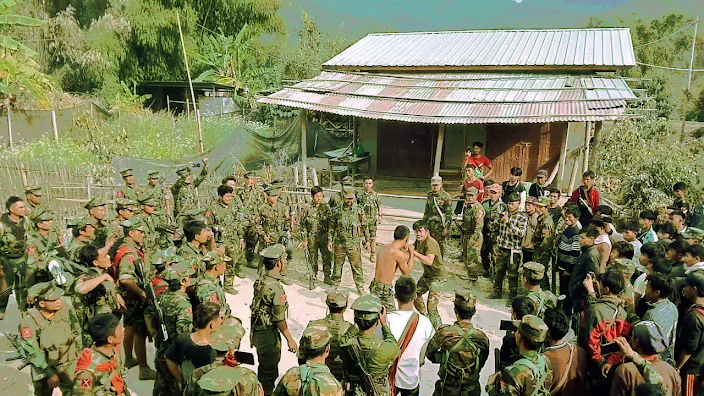Myanmar Spring Chronicle – March 26 Scene
Moemaka, March 27, 2025
TNLA and the Territorial Dispute in Northern Shan State
In the late 2023 and mid-2024 period, the military successes of the three ethnic armed organizations collectively known as the “Northern Brotherhood Alliance” — MNDAA, TNLA, and AA — made headlines. These victories boosted the morale of all Spring Revolution supporters, who came to view the success in Northern Shan as a part of the broader revolutionary victory.
MNDAA managed to reclaim its autonomous territory during the first phase of Operation 1027 and then captured the city of Theinni. The adjacent town of Kutkai, connected via a major highway, was taken by TNLA. In the second phase of the operation, MNDAA also captured Lashio — a city not originally within its autonomous area — and TNLA seized control of Mogok, Kyaukme, Nawnghkio, and Hsipaw.
Although AA participated in the Operation 1027 offensives alongside the alliance, it did not take part in administering the captured territories. This was because the areas in question are home primarily to Ta’ang/Pa Laung, Shan, Kachin, and Kokang ethnic communities — and not Rakhine, the ethnic base of AA.
The 1027 operations were not limited to the three Northern Brotherhood groups. Other armed forces from various regions also joined the offensive. While some reports refer to “forces allied with TNLA” or “forces allied with MNDAA,” there is little concrete information on which groups joined from which areas or in what numbers, due to the military secrecy involved. However, groups like BPLA, PLA, KNDF, and PDFs from Sagaing, Mandalay, and southern Shan were all reported to have participated.
It is widely believed that while MNDAA, TNLA, and AA led the offensive, the other groups fought under their command. What remains unclear is whether there were formal agreements on territory division post-victory or if allied groups joined purely based on shared goals like the fall of the junta. Some media reports mentioned agreements such as “troops provided, weapons received,” but beyond that, detailed arrangements are unknown. Other interpretations suggest PDF fighters may have joined to gain combat experience — raising questions about whether they risked their lives solely for that purpose.
During the second phase of Operation 1027, TNLA, alongside MNDAA, achieved significant territorial gains, including the cities of Kyaukme, Nawnghkio, Mogok, and Hsipaw. However, as they moved into regions near KIA (Kachin Independence Army) territory like Kutkai and Momeik — historically part of the British-era “Kachin Sub-State” — tensions have arisen. These include minor conflicts, disarmament efforts, and the closing of liaison offices.
These incidents raise questions about how ethnic armed groups will handle mutual cooperation, territorial governance, and border demarcation in multi-ethnic zones. It also raises the concern of whether TNLA could risk damaging its alliance relations over territorial control.
As the junta, which had been on the back foot since early 2023, begins to regain some ground in places like southern Shan and threatens cities like Nawnghkio, TNLA will need strong, unified alliances with other anti-junta forces more than ever.
Even if TNLA doesn’t face a direct ceasefire demand from China, border trade, resource supplies, and fuel imports through China could face disruptions. These hardships are likely aimed not just at TNLA but at pressuring the civilians in TNLA-controlled areas — a strategy meant to weaken TNLA indirectly.
The most crucial risk TNLA now faces is losing the trust of its allied ethnic armed organizations.
In recent days, tensions and disputes between TNLA and KIA, as well as between TNLA and SSPP/SSA, have surfaced on social media — with many comments indicating a decline in public support for TNLA. While it’s true that online criticism can be amplified by lobby accounts and orchestrated campaigns, it would be wrong to dismiss them entirely — they still reflect a portion of public sentiment.

